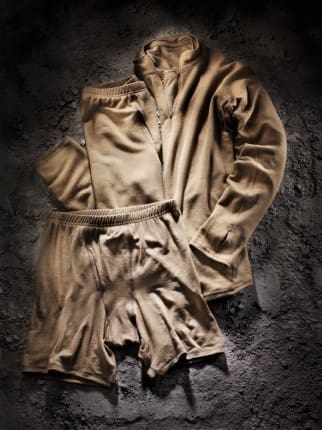Wool really makes sense for military garments but a couple of things have happened over the years that have pushed it to the back of the line. In the late 1980s new, man-made fabrics began to come on the military scene that out performed the issue wool garments which dated back to before WWI. Troops were more than happy to ditch the itchy long johns that their great grandfathers had worn into battle on the Western Front. But then came the IED. Unnaturally (pun intended), the answer was to develop new man made FR performance fabrics since the recently adopted polypropylene and polyester fabrics used in military base layers are very flammable. This was a very costly undertaking. So where was wool, nature’s performance fiber through all of this? Quite frankly, it wasn’t quite ready to make a return.
Traditionally there have been several criticisms of the use of wool:
-Comfort (that itchy feeling)
-Limited domestic availability of Merino wool (considered the best wool for next to skin use, not itchy)
-Shrinkage
-Smell
-Lack of domestic treatment due to EPA guidelines
Despite these generic criticisms, the benefits of Merino wool are myriad:
-Warm even when wet
-Comfortable in a wide range of temperatures as well as against the skin
-Antimicrobial
-Inherently FR (No Melt, No Drip)
We are now at the point where we have almost an entire Army that has never used wool undergarments, and those that have probably don’t have the fondest of memories. Truthfully, current military attention towards wool has been driven by troops with an interest in the outdoors, as commercial wool garments have gotten better and better of the past few years. This has been combined with a concern by those who keep the Army’s purse strings, as they are constantly seeking more economical ways to accomplish the mission.
To mitigate the common criticisms of wool, New Balance has combined Merino with FR Rayon to increase performance and durability. This also increases the FR properties of wool and facilitates field laundering. Then, they have treated the resulting fabric with X-static to further enhance wool’s natural anti-microbial properties to reduce stink. Additionally, there is finally an environmentally green US-based wool treatment facility. Treatment is critical to improving the comfort and performance of the wool. While the US Merino herd is small, as with all things “domestic textile”, the military is a prime customer. In fact, all of the components have just recently aligned in order to allow New Balance to produce a Berry compliant product.
New Balance has developed several garments including Base Layer long and short-sleeved T-shirts, Briefs, light and mid-weight Long Underwear Pants, and a Performance 1/4-zip Shirt. Initially, the plan was to have the Merino products available by July, but user feedback from the test items has been so strong that New Balance is looking to accelerate their schedule.
Units interested in New Balance military products should contact ADS.
Tags: New Balance


